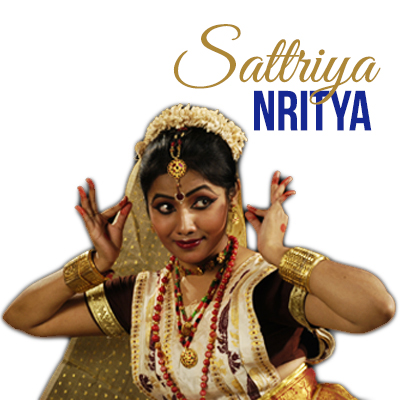
The syllabus has been designed for four semesters and aims in introducing to the students the rudiments of Sattriya Dance Aesthetics. During the discussions of the issues and concerns of the Sattriya dance tradition, attention will be given to provide the holistic appraisal of dance and develop dance appreciation amidst the students. Also, focus shall be given to introduce the students to the interdisciplinary nature of dance through practical skills. Hence, special lectures and interactive sessions with the resource persons and field visits will also be included during the course. Dance festivals, and workshops would also be planned in which students will be able to learn and observe a renowned performer’s work and interact with them. The sessions would also have few audio visual presentations of some renowned master’s work. The classes for the course will be divided between the discussions of theoretical issues and practical sessions and some with intense practical sessions. Group discussions and question answer sessions will be encouraged during the classes. Skill Test and Assignments need to be given at the end of the Semester. Certificates will be provided at the successful completion of the course.
COURSE OBJECTIVES:The Sattriya Dance Course aims in providing
- A wider view of the Sattriya Dance tradition with a fresh outlook.
- A notion of dance through various creative interpretations.
- An understanding of the cultural and rich heritage of the land, Assam.
- Improvement in communication skills and body language.
- Improvement in concentration and release of stress through exercise sciences.
- Understanding the importance about body fitness through yoga, warm up and warm down exercises.
- To appreciate dance as an – art work in relation to photographing, video graphing movements, and so on.
- A glimpse of the 500 year old living dance heritage of Assam, Sattriya Dance
1st Year
Semester 1: Performing Arts Course: Sattriya Dance
Theory: Introduction to Indian Dance: Historicity and its Aesthetics; An Overview of Sattriya Dance: A Socio-historical and Aesthetic Perspective; A Basic Introduction of the Bhakti Movement in Assam and various cultural expressions; Life Sketch of Sankaradeva , Introduction to Sattriya Dance - Distinctive Features; Assignment.
Practical: Mati Akharas along with the Mnemonic syllables of the movements; Hand-gestures; Few foot work with names, Jhumura Ramdani.
References:[1] Leela Venkataraman, Indian Classical Dance: Tradition in Transition, Roli Books, 2002.
[2] Maheswar Neog, Early History of the Vaisnava Faith and Movement in Assam: Sankaradeva and his Times. Motilal Banarsidass. 1985.
[3]Sattriya Nritya Aaru Sattriya Nrityar Taal. Asom Prakashan Parishad. 2008 (First Edition 1973)
[4] Revital Carrol, Mudras of Indian Dance, Singing Dragon, 2013.
Semester 2: Performing Arts Course: Sattriya DanceTheory: Understanding few critical concepts of Dance ( Nritta, Nritya, Natya, Laya, Tala, Matra, ; Sattra Institutions of Assam; Definitions of the Dance Numbers; Dance Notation, Field Visit, Assignment. Life and Works of Madhavadeva, Basic idea of few Dance Treatises
Practical: Practice of Mati Akharas and Jumura Ramdani and Geetar Nac; Hand gestures and its Usages, Neck movements, Eye Movements, Guru Bandana/ Sloka, Knowledge of Talas ( Chuta, Thukoni, Jati, Ektal with ), Ghat and Chok.
References[1] Leela Venkataraman, Indian Classical Dance: Renaissance and Beyond. Niyogi Books, 2015.
[2] Ghanakanta Bora and Pradip Jyoti Mahanata. Sattriya Nrityar Aitijya and Abhas. Asom Prakashan Parishad. 2007.
[3] Kapila Vatsyayan, Bharata’s The Natyashastra, Sahitya Akademi, 2001.
[4] Maheswar Neog, Aesthetic Continuum: Essays on Assamese Music, Dance, Drama and Painting. Omsons Publications, 2008.
[5] Pradip Jyoti Mahanta, The Sankaradeva Movement: Its Cultural Horizons. Purvanchal Prakash, 2007.
2nd YearSemester 3: Performing Arts Course: Sattriya Dance
Theory: Dance Appreciation and Rasaaesthetics; Navarasa, Life Sketch of Eminent exponents of Sattriya Dance, Ankia Nat – Distinctive Features, Interview / Interaction with eminent artist, Definition of the dance numbers. Assignment.
Practical: Practice of the above mentioned dance numbers; Jumura Mela Nac, Cali Ramdani (Hajowaliya), Cali Geetar Nach (with abhinaya).
References:[1] Pradip Jyoti Mahanta (Ed), Vaisnavite Music of Assam: Its Institutionalization and Performative Context. Guwahati: Purvanchal Prakash. 2016.
[2] Sunil Kothari, Sattriya: Classical Dance of Assam, Marg Publications, 2013.
Semester 4 Performing Arts Course: Sattriya DanceTheory: Basic Idea of Dance Studies, Aesthetic Appraisal of Dance; Dance Writing/ Dance Research, Definitions of the dance numbers included in the practitional aspect, Coverage (Report/ Review) of a dance festival. Assignment.
Practical: Nadubhangi Ramdani, Abhinaya of Geet; Entry-Exit sequences of Characters in relation to Bhaona, Sutradhari Nac.
References:[1] Mandakranta Bose. Movement and Mimesis: the Idea of Dance in Sanskritic Tradition. Springer Science & Business Media, 2012.
[2] A. Carter. Routledge Dance Studies Reader. London: Routledge. 2010.
COURSE FORMCourse Instructor - Dr. Anwesa Mahanta Know More